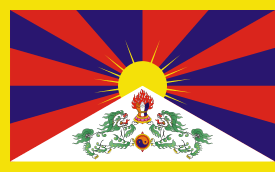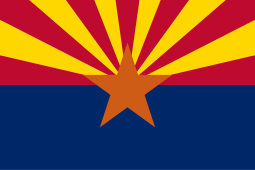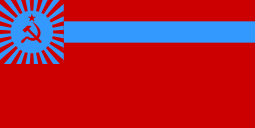Rising Sun Flag
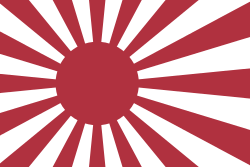
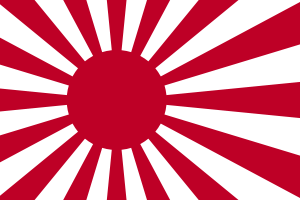
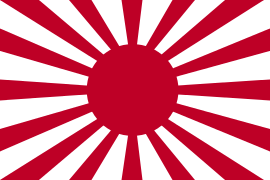
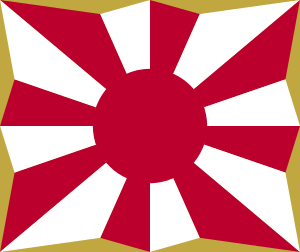
The Rising Sun Flag (旭日旗 Kyokujitsu-ki) design was originally used by feudal warlords in Japan during the Edo period.[1] On May 15, 1870, as a policy of the Meiji government, it was adopted as the war flag of the Imperial Japanese Army, and on October 7, 1889, it was adopted as the naval ensign of the Imperial Japanese Navy.[2] It is still used in Japan as a symbol of tradition and good fortune, and is incorporated into commercial products and advertisements. The flag is currently flown by the Japan Maritime Self-Defense Force and a modified version is flown by the Japan Ground Self-Defense Force. It is viewed as a symbol associated with Japanese imperialism in the early 20th century in South Korea,[3][4][5] North Korea, China,[6] and by some veterans in the United States[7][8][9] because of its use by Japan's military forces during that period.
Design
The design is similar to the flag of Japan, which has a red circle in the center signifying the sun. The difference compared to the flag of Japan is that the Rising Sun Flag has extra sun rays (16 for the ensign) exemplifying the name of Japan as "The Land of the Rising Sun". The Imperial Japanese Army first adopted the Rising Sun Flag in 1870.[10] The Imperial Japanese Army and the Imperial Japanese Navy both had a version of the flag; the naval ensign was off-set, with the red sun closer to the lanyard side, while the army's version (which was part of the regimental colors) was centered. The flag was used until Japan's surrender in World War II during August 1945. After the establishment of the Japan Self-Defense Forces in 1954, the flag was re-adopted and approved by the GHQ. The flag with 16 rays is today the ensign of the Maritime Self-Defense Force while the Ground Self-Defense Force uses an 8-ray version.[11]
Present-day use
The Rising Sun flag appears on commercial product labels, such as on the cans of one variety of Asahi Breweries lager beer.[12] The design is also incorporated into the logo of the Japanese newspaper Asahi Shimbun. Among fishermen, the Tairyō-ki (大漁旗 Good Catch Flag) represents their hope for a good catch of fish. The flag is also used at sporting events by the supporters of Japanese teams.[13] Some extreme right-wing groups display it at political protests.[14] The flag is also used by non-Japanese, for example, in the emblems of some U.S. military units based in Japan, and by the American blues rock band Hot Tuna, on the cover its album Live in Japan.
Issues regarding the flag in China and South Korea
Due to the flag being used by the Imperial Japanese military and Japan's actions during World War II, many Koreas[3][4][5] and Chinese[6] find the flag to be offensive. Because of this, the use of the flag is considered to be controversial. For example, during the 2008 Beijing Olympics, Japanese fans were warned not to fly the flag as it would offend and cause trouble with both Chinese and South Koreans.[15][16] Although they complain about the rising sun flag, no country prohibits from using it by law. Even China and South Korea, the countries that most often condemn the rising sun flag have hardly ever remarked about the use of the flag before the 2000s. In 2013, Sohn Yin-Choon (손인춘), a member of the Congress in South Korea finally insisted that the law about the rising sun flag should be instituted.[17]
Examples of the Rising Sun design in use
-

Flag of the Asahi Shimbun Company.
-

Asahi Gold Beer
-

Lucky Gods' visit to Enoshima, Ukiyo-E print by Utagawa Yoshiiku, 1869.
United States Military
-

Emblem of United States Fleet Activities Sasebo.
-

Patch of Strike Fighter Squadron 94.
-

Emblem of US Army Aviation Battalion Japan.
-

The mural painted on a wall at Misawa Air Base, Japan.
-
Former insignia of Strike Fighter Squadron 192.
-
Joint Helmet Mounted Cueing System with patches of the 14th Fighter Squadron.
Similar flags
-

Flag of Russian Air Force
-
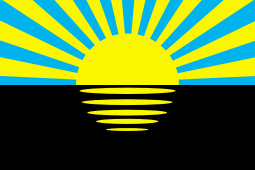
Flag of Donetsk Oblast, Ukraine
-

Flag of the Karen National Liberation Army
-

Korean Unification Church Flag
-

Royal Standard of Jordan
See also
| Wikimedia Commons has media related to Rising Sun Flag of Japan. |
References
- ↑ "Japanese Symbols". Japan Visitor/Japan Tourist Info. Retrieved October 9, 2014.
- ↑ "船舶旗について" (PDF). Kobe University Repository:Kernel. Retrieved October 18, 2014.
- 1 2 Radhika Seth (August 14, 2012). "Courting Controversy: Olympic Uniform resembled rising sun flag!". Japan Daily Press. Retrieved September 18, 2012.
- 1 2 "Korean lawmakers adopt resolution calling on Japan not to use rising sun flag". Korea Herald. August 29, 2012. Retrieved September 18, 2012.
- 1 2 "Japanese "Rising Sun Flag" Sparking More Tension between Korea and Japan". Business Korea. August 9, 2013.
- 1 2 Naoto Okamura (August 8, 2008). "Japan fans warned not to fly naval flag". Reuters.
- ↑ Bill McMichael (August 2, 2011). "That Flag". Navy Times Scoop Deck.
- ↑ Tom Hester (November 3, 2008). "Trenton's 'Lady Victory' monument honors W W II vets". NJ.com.
- ↑ Martin Kidston (April 26, 2014). "Hellgate High senior will escort WWII veterans on final Big Sky Honor Flight". Missoulian.
- ↑ "海軍旗の由来". kwn.ne.jp. Retrieved 6 October 2011.
- ↑ Phil Nelson; various. "Japanese military flags". Flags Of The World. Flagspot.
- ↑ "Asahi Beer New Design". Japan Visitor Blog. December 12, 2011.
- ↑ "A great decade for Japan". FIFATV. 2012-12-18.
- ↑ "World: Asia-Pacific Reprise for Japan's anthem". BBC News. August 15, 1999.
- ↑ Okamura, Naoto (8 August 2008). "Japan fans warned about rising sun flag". Reuters. Retrieved 5 April 2012.
- ↑ "Japan fans warned about rising sun flag". Japan Probe. 8 August 2008. Retrieved 5 April 2012.
- ↑ ""국내서 욱일기 사용땐 처벌" 법 개정한다". article.wn.com. Retrieved 2016-03-25.

